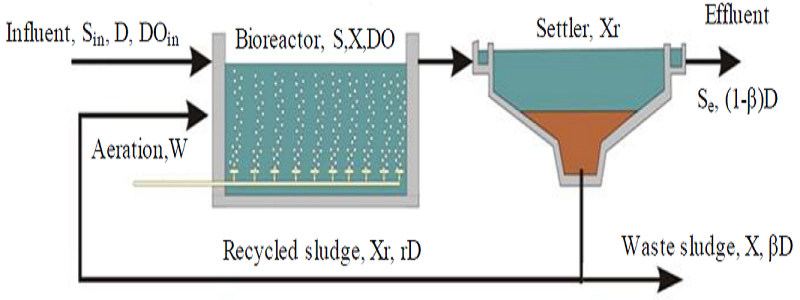Improving Activated Sludge Wastewater Treatment Process Efficiency Using Predictive Control
Keywords:
predictive control, process optimization, process model, wastewater treatment plant, activated sludge treatmentAbstract
This paper investigates the performance of a new predictive control approach used to improve the energy efficiency and effluent quality of a conventional Wastewater Treatment Plant (WWTP). A modified variant of the well-known Generalized Predictive Control (GPC) method has been applied to control the dissolved oxygen concentration in the aerobic bioreactor of a WWTP. The quadratic cost function was modified to a positional implementation that considers control signal weighting and not its increments, in order to minimize the control energy. The Activated Sludge Process (ASP) optimization using the proposed variant of the GPC algorithm provides an improved aeration system efficiency to reduce energy costs. The control strategy is investigated and evaluated by performing simulations and analyzing the results. Both the set point tracking and the regulatory performances have been tested. Moreover, the effects of some tuning parameters are also investigated. The results show that this control strategy can be efficiently used for dissolved oxygen control in WWTP.
References
U. Jeppsson, “Modelling aspects of wastewater treatment processes,” Ph.D. thesis, Dept. of Industrial Electrical Eng. and Automation, Lund University, Sweden, 1996.
D. Brjdanovic, S. C. F. Meijer, C. M. Lopez-Vazquez, C. M. Hooijmans, M. C. M. van Loosdrecht, “Applications of activated sludge models,” London:IWA Publishing, 2015.
R. Katebi, M. A. Johnson, and J. Wilkie, Control and instrumentation for wastewater treatment plants, Springer, London, 2012.
M. A. Brdys, M. Grochowski, T. Gminski, K. Konarczak, and M. Drewa, “Hierarchical predictive control of integrated wastewater treatment systems,” Control Engineering Practice, vol. 16, no. 6, pp. 751-767, June 2008.
N. S. Iordache, C. Petrescu, G. Necula, and Busuioc, “Municipal wastewater treatment improvement using computer simulating, advances in waste management,” Proc. the 4th WSEAS International Conf. Waste Management, Water Pollution, Air Pollution, Indoor Climate (WWAI’10), May 2010, pp. 95-100.
I. Naşcu, G. Vlad, S. Folea, and T. Buzdugan, “Development and application of a PID auto-tuning method to a wastewater treatment process,” 2008 IEEE International Conf. Automation, Quality and Testing, Robotics, IEEE Press, August 2008, pp. 229-234.
J. Kocijan, N. Hvala, and S. Strmčnik, “Multi-model control of wastewater treatment reactor,” System and control: theory and applications, pp. 49-54, 2000.
G. Vlad, R. Crişa, B. Mureşan, I. Naşcu, and C. Dǎrab, “Development and application of a predictive adaptive controller to a wastewater treatment process,” 2010 IEEE International Conf. Automation, IEEE Press, July 2010, pp. 219-224.
S. Mirghasemi, C. J. B. Macnab, A. Chu, “Dissolved oxygen control of activated sludge biorectors using neural-adaptive control,” Proc. IEEE Symp. Computational Intelligence in Control and Automation, Dec. 2014. pp. 1-6.
B. Holenda, E. Domokos, A. Redey, and J. Fazakas, “Dissolved oxygen control of the activated sludge wastewater treatment process using model predictive control,” Computers and Chemical Engineering, vol. 32, no. 6, pp. 1270-1278, June 2008.
I. Naşcu and I. Naşcu, “Modelling and optimization of an activated sludge wastewater treatment process,” European Symp. Computer Aided Process Engineering, IEEE Press, December 2016, pp. 1159-1164.
C. Belchior, R. Araújo, and J. Landeck, “Dissolved oxygen control of the activated sludge wastewater treatment process using stable adaptive fuzzy control,” Computers and Chemical Engineering, vol. 37, pp. 152-162, February 2012.
G. Harja, I. Nascu, C. Muresan, and I. Nascu, “Improvements in dissolved oxygen control of an activated sludge wastewater treatment process,”Circuits Systems and Signal Processing, vol. 35, no. 6, pp. 2259-2281, June 2016.
D. W. Clarke, C. Mohtadi, and P. Tuffs, “Generalized predictive control part 1. the basic algorithm,” Automatica, vol. 23, no. 2, pp. 137-148, March 1987.
W. Gujer, M. Henze, T. Mino, and M. Van Loosdrecht, Activated sludge models ASM1, ASM2, ASM2d and ASM3, IWA Publishing, 2000.
S. Cristescu, I. Naşcu, and I. Naşcu, “Sensitivity analysis of an activated sludge model for a qastewater treatment plant,” Proc. International Conf. System Theory, Control and Computing, pp. 595-600, October 2015.
I. Muntean, R. Both, R. Crisan, and I. Nascu, “ RGA analysis and decentralized control for a wastewater treatment plant,” Proc. the IEEE International Conf. Industrial Technology, March 2015, pp. 453-458.
G. Harja, C. Mureşan, G. Vlad and I. Naşcu, “ Fractional order PI control strategy on an activated sludge wastewater treatment process,” 17th International Conf. System Theory, Control and Computing (ICSTCC), IEEE Press, October 2015.
G. Harja, G. Vlad, and I. Naşcu. “Dissolved oxygen control strategy for an activated sludge wastewater treatment process,” Recent Advances in Electrical Engineering Series. Proc. the 19th International Conf. Systems (CSCC'15), July 2015 pp. 453-458.

Published
How to Cite
Issue
Section
License
Submission of a manuscript implies: that the work described has not been published before that it is not under consideration for publication elsewhere; that if and when the manuscript is accepted for publication. Authors can retain copyright in their articles with no restrictions. is accepted for publication. Authors can retain copyright of their article with no restrictions.
Since Jan. 01, 2019, AITI will publish new articles with Creative Commons Attribution Non-Commercial License, under The Creative Commons Attribution Non-Commercial 4.0 International (CC BY-NC 4.0) License.
The Creative Commons Attribution Non-Commercial (CC-BY-NC) License permits use, distribution and reproduction in any medium, provided the original work is properly cited and is not used for commercial purposes.



